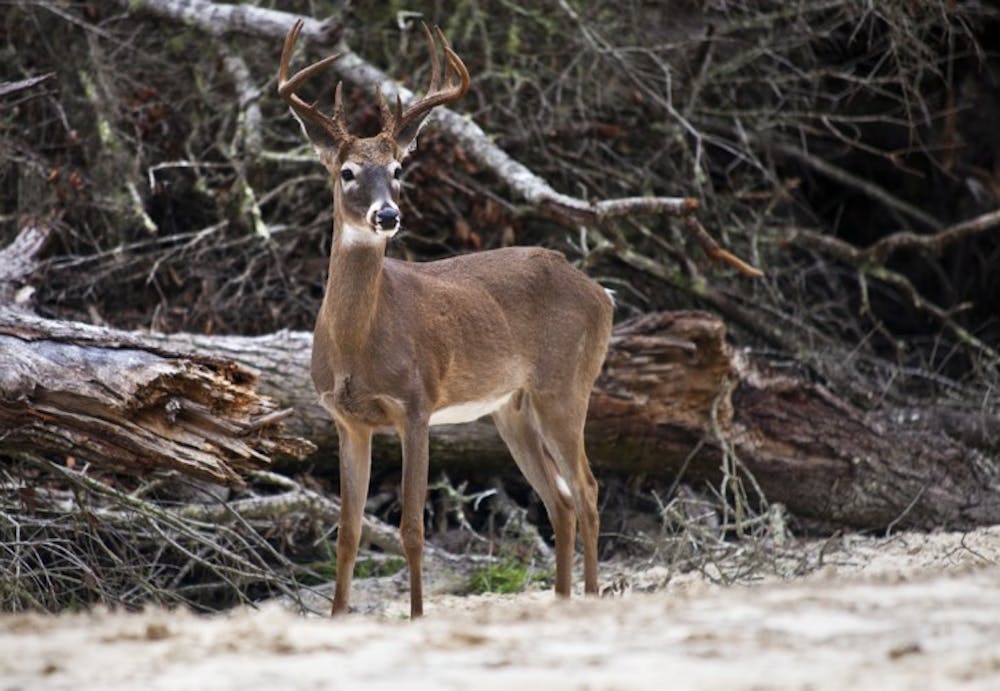Donnie Young starts his mornings watching deer from his front-porch rocking chair.
The 38-year-old former All-SEC offensive guard sits as the sun rises and listens to the rustling of deer. He waits and worries.
Nowadays, between fretting about tangled pigtails and preschool classes, Young’s biggest fear is a small fly carrying a deadly disease.
The noseeum, named for being so small that you can’t “see ‘um,” is Young’s 3-millimeter menace.
The fly carries epizootic hemorrhagic disease, or EHD, which is fatal to the white-tailed deer that roam his ranch, DY Trophy Ranch. Aside from his wife and children, he said his life revolves around deer, and EHD is an epidemic that threatens that life.
“When it occurs, it’s devastating to the white-tailed deer population,” Phillip Kaufman, a UF associate professor of veterinary entomology, said. “This year in Florida, we’re having a bigger outbreak.”
Young, president of the Florida Deer Association, said EHD has affected herds of white-tailed deer for “eons,” but the Florida Fish and Wildlife Conservation Commission released a notice in September asking hunters to report incidences of the disease.
“It looks like the flu,” Young said. “Their chance of survival is 50-50 at best, but it’s really about 70-30.”
Another problem is that when the meat starts to decompose, the virus dies. All evidence is gone within 24 hours.
It’s tough to find deer that quickly.
Young patrols his ranch every day to check on the hundreds of deer that roam the property.
His daughter Kaley, 6, and her 5-year-old sister, Kinsey, ride with their dad to his ranch when the weather is cool.
Sometimes he lets Kaley take the wheel of the Polaris Ranger off-roader. Standing up at the wheel, she nearly disappears behind her daddy’s trunk-sized legs, but her pink, kid’s size 11 Fatbaby Cowgirl boots still stand out.
When they come across a deer that looks sick, he mixes a medicine cocktail and loads it into his air gun.
Young said it’s tough to tell the difference between an unhealthy deer and one with EHD. Their show through their skin from malnourishment, their heads droop and saliva drips from their mouths.
He shoots the sick deer with the antibiotic dart and waits a few days. When they have EHD, they rarely get better.
“Instead of a dart, you’d almost rather give them a bullet,” he said. “It’s better than having them suffer.”
One of the biggest problems about monitoring the disease is the deer can die within hours of being infected. Sometimes death can take weeks, but it’s usually within a couple of days.
“We’re looking for help to keep monitoring this,” Kevin Baxter, the spokesman for the Florida Fish and Wildlife Conservation Commission, said.
When a deer gets the disease, areas in its neck and head swell, and it will seek a quiet place to be alone. In the thicket of oaks, pines and palms, there are plenty of places to hide, even from an experienced hunter like Young.
Sometimes it’s easy to find deer that have been affected. They’ll try to cool themselves off. He’ll find them floating in one of the lime-green lakes.
He said losing deer to disease isn’t just sad — it’s costly. Some of the deer used for breeding can fetch up to $500,000.
He said the disease is brought up frequently at the Florida Deer Association’s meetings, where they discuss things like the cost of feed and herd health.
“When EHD hits, it’s often seen where deer populations are high,” Kaufman said. “An individual farmer may lose large numbers of their deer.”
“We lose millions of dollars of captive herd animals, and in the wild, there’s no telling,” Young said.
Kaufman said the noseeums can’t reproduce in moving water. But when heavy rains come in the summer, they create large puddles, perfect for breeding.
“We see it go away when we get to freezing temperatures,” Young said.
To fight the disease, Young and Dwight Knight, the former president of the Florida Deer Association, developed a vaccine by using organs of dead animals to isolate the virus.
“It’s probably one of the worst diseases affecting herds,” he said. “Hopefully we’ll have a good winter. We’re going to need it.”
Contact Alex Catalano at acatalano@alligator.org.
A buck lingers by a pile of discarded trees near a manmade lake on the 1,000-acre DY Trophy Ranch in Cross City, Fla., on Saturday.






